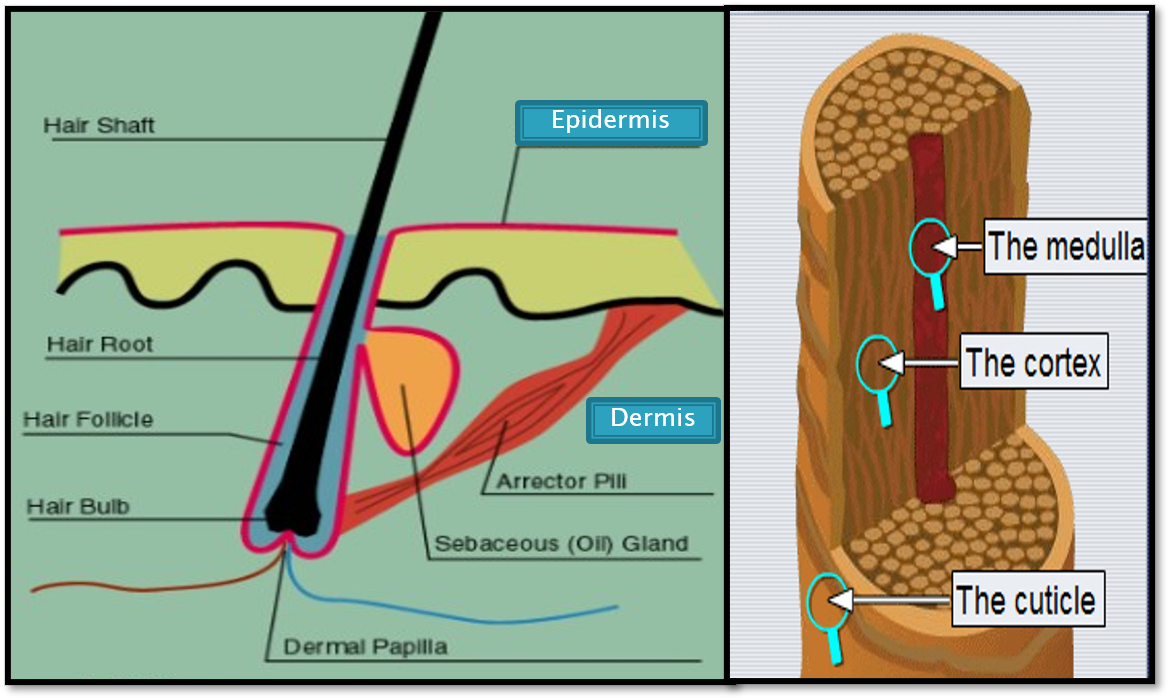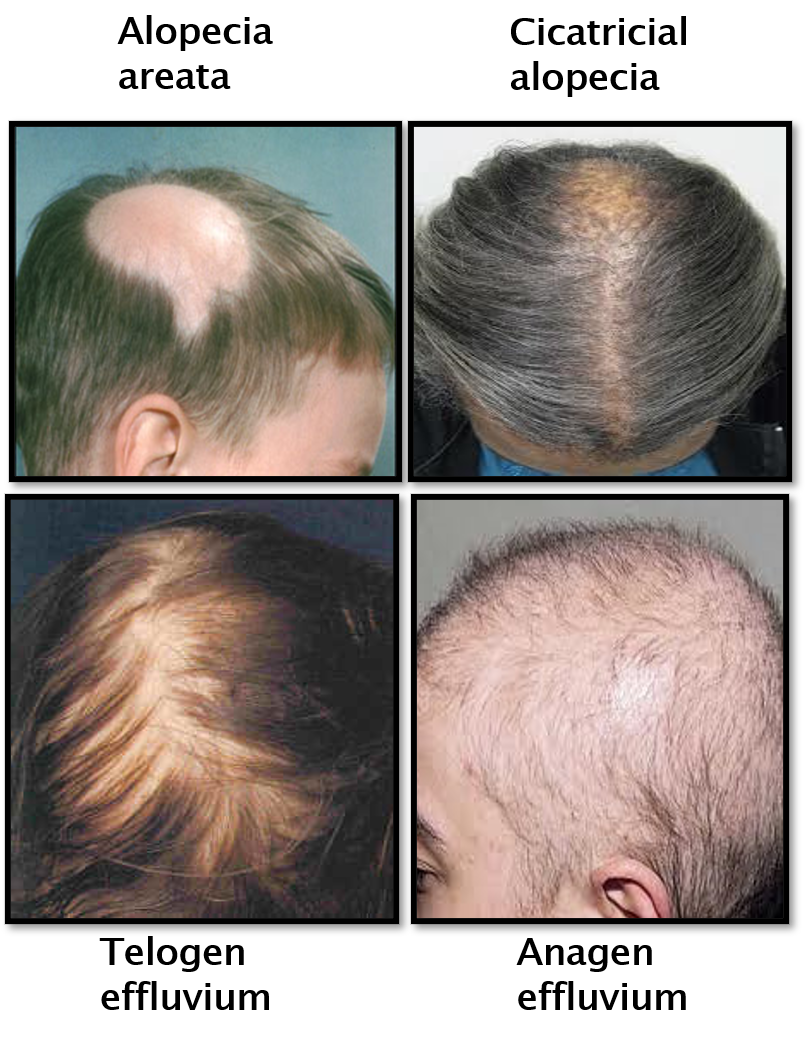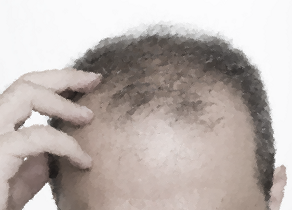Hair fall and hair loss or balding are common problems and can be related to nutrition, lifestyle and age, but sometimes other causes may also be present.
HAIR STRUCTURE
Each strand of hair has a bulb and root enclosed inside a hair follicle in the deeper layer (dermis) of the skin. The shaft ending in the hair tip protrudes above the superficial skin layer (epidermis). The hair bulb (containing the matrix – region of active cell division and new hair formation) is nourished by the blood vessels in the skin that enter the hair follicle through a raised part at its base, called the dermal papilla. Each hair follicle has attached a sebaceous gland that secretes oil and lubricates the hair. A muscle called erector pili connects the hair follicle to the epidermis. The contraction of this muscle in response to emotion or temperature causes the hair to stand (goosebumps). However, this is visible only with skin hair, as scalp hair is dense and longer, and sensory receptors are lesser in scalp skin.



The hair is covered by the cuticle made up of keratin (the tough protein in the outer epidermis layer of skin) and ceramides (a type of waxy fat). The cuticle protects the hair, keeps it supple and lubricated, and prevents it from getting dry (dry hair is more easily breakable). Under the cuticle is the cortex layer made up of keratin and the keratinocytes (skin cells producing keratin), along with collagen and laminin (proteins of the dermis layer) and melanocytes (skin cells producing pigment for color). Keratin makes up 80% of the hair structure giving it protection and tensile strength against breakage. The deepest hair layer is the medulla that is mainly made up of pigment.
The cycle of hair growth and regeneration are divided into the anagen (active growth phase) and telogen (resting phase) with a transition stage in between called catagen.
CAUSES OF HAIR FALL, HAIR LOSS AND BALDING
Age
Both men and women develop hair loss with increasing age as hair formation and growth reduce. In men, this usually manifests as male pattern balding which is a receding hairline with hair thinning on the crown. In females, it manifests as overall hair thinning. Hair also starts to lose pigment (color) with age.
Nutrition and Lifestyle
Certain nutrient deficiencies in diet have been linked to hair fall. These include proteins, the B vitamin biotin, and the minerals iron, calcium, selenium and zinc. Generally, a diet rich in proteins, polyunsaturated fatty acids (PUFAs), vitamin and minerals, and low in carbs and saturated fat is recommended for health and wellness, including that of hair.
Prolonged exposure to air pollution from urban industries and exhaust fumes as well as cigarette smoke, and working long hours in the sun, may contribute to or worsen hair loss. Regular hair wash in very hot water, excess use of heat dryers, hair bleaching or dyeing agents, and harsh shampoos with high alcohol content can also increase hair loss. Chronic stress also impacts hair health.
ALOPECIA
Alopecia refers to development of areas of balding.
Androgenetic Alopecia
It is also called androgenic alopecia, that is age related balding and hair loss. In men, balding occurs due to an interplay of increasing age, genetics and male hormones (dihydro testosterone – DHT). It appears as receding hairline with hair loss on the crown.
In females, it manifests as thinning of hair starting at the parting and then at the top of the head.



Traction Alopecia
It is a type of hair loss that occurs due to hair pulling, tight hairstyles (ponytails/braids/bun), and hair styling instruments (hair pressors, straighteners, perming or curlers that repeatedly pull on the hair). Some people pull their hair to relieve stress or as part of a psychological condition (trichotillomania). Timely correction of hairstyles and stoppage of pulling can help reverse hair loss, however, if such processes are continued for a long time, hair loss can be permanent.
Cicatricial Alopecia
This refers to the destruction of hair follicles and the development of areas of balding due to scarring after an inflammatory condition of the scalp. It may be associated with burning, itching and pain. Cicatricial alopecia can occur at any age and may be primary (cause unknown) or secondary (due to scalp infections, injury, burns, radiation, or tumors).
Alopecia Areata
Alopecia areata (meaning balding patches) is an autoimmune disease (body’s immune system mistakenly attacks the hair follicles) causing hair loss. It can manifest at any age but most people develop it by 30 years of age, and often it begins in childhood or the teenage years. Sometimes hair may even be lost from skin, nose, eyebrows or eyelashes, along with the scalp.
EFFLUVIUM HAIR LOSS
This refers to sudden hair loss in large amounts (effluvium) over a short span of time. This can happen due to many causes, classified by the stage in the hair cycle where the arrest happens.
Telogen effluvium is a type of hair loss that involves rapid hair loss, typically seen sometime (2-3 months) after the body has undergone intense physical or emotional stress or hormonal changes, like surgery, infection, any serious illness, hospitalization, emotional trauma (loss of a relationship or loved one) or childbirth. This kind of hair loss was also seen post-COVID infection. It often needs only supportive care, and shows spontaneous recovery.
Anagen effluvium is hair loss due to exposure to chemotherapy drugs, radiation or toxic chemicals like thallium, boron, mercury, and arsenic. It can also occur due to large doses of the drug warfarin (found in rat poisons), sometimes with very high doses of vitamin A or selenium, and exposure to other toxic and damaging substances. Hair growth usually begins again after eliminating exposure to the cause, but sometimes there may be textural and colour changes in the new hair.



SCALP CONDITIONS
Scalp Psoriasis
Psoriasis is a chronic inflammatory skin condition thought to have an autoimmune etiology. It presents with rashes, developing into scales and plaques. Stress, cold and infection are known triggers. Psoriasis can involve the scalp, nails and joints in addition to the skin. The development of psoriasis plaques in the scalp can lead to hair loss.
Scalp Infections
Infections can be fungal infections (Tinea capitis – ringworm of the scalp) can cause temporary patchy hair loss. Sometimes bacterial infections of the hair follicles (folliculitis) may also be associated with temporary hair fall and loss of hair from that particular area of the scalp.
Sexually transmitted diseases (STDs) like syphilis can cause patchy hair loss from not only the scalp hair, but also eyebrows and beard.
Dandruff (seborrhea) refers to the flaking of the skin of the scalp. Too much oil production and build-up of dead cells on the skin is the cause, and this often leads to itching. The fungus Malassezia feeds on excess oil and can cause dandruff-associated scalp inflammation (seborrheic dermatitis) that manifests as itchy red patches and greasy scales along with white or yellow crusty or powdery flakes on the scalp.
Lice infestation of the scalp can also cause intense itching and unlike dandruff, it spreads from person to person.
Dandruff and Lice as such do not cause hair fall or hair loss, but intense and prolonged itching causing long-standing associated inflammation can cause scarring of some of the hair follicles and stoppage of hair growth from them.
OTHER CAUSES
Hormonal problems
Hormonal imbalances and disturbances are common causes of hair loss especially in women, and must be evaluated for. This includes taking oral contraceptives or conditions like polycystic ovary syndrome (PCOS), and thyroid disorders. Sometimes diabetes, and disorders of the pituitary gland or adrenal cortex, can also cause hair loss.
Medications
Hair loss is a relatively rare side effect, of some drugs including beta-blockers, blood thinners, antidepressants, cholesterol-lowering drugs, certain nonsteroidal anti-inflammatory drugs (NSAIDs) and hormone-related drugs like thyroid medicines, hormone replacement therapies or steroids.
MANAGING HAIRFALL, HAIRLOSS AND BALDING
In every case of hair fall, a complete medical evaluation should be done in accordance with the person’s age. This includes a careful history of when the hair loss started and details of the type of hair loss or amount of hair fall (around 100 strands/day especially while combing is normal). The type of diet and lifestyle, living and working environment, hair care habits and styling practices should be enquired into. One should also assess any associated current or recent physical or emotional health issue or event, other physical symptoms present, menstrual history in females, exposure to any harmful substances, and medications taken.
A detailed examination of the scalp will help assess the areas of hair loss or balding, and the presence of any local scalp disease, infection, inflammation or scarring.
Sometimes blood tests may be recommended to check hemoglobin and blood counts, diagnose iron deficiency, and evaluate blood sugar, thyroid hormones, and other hormone levels where needed.
Treatment should be in accordance of underlying factors.
Diet
A healthy balanced nutritious diet builds the foundation of healthy hair too. Including the required quantity of proteins (from egg whites, chicken/fish, soy, dairy products and whey), green vegetables, fruits, curd, and healthy fats (like omega 3) in your daily diet with plenty of water for hydration, can take care of your hair too. Hair health supplements are rarely required if diet is healthy, however, doctors may prescribe such supplements in hair fall.
Hair Health Supplements
These usually have all the minerals and vitamins, along with some essential amino acids (protein building blocks). Cysteine is an important amino acid for hair as it is the building block for keratin. Biotin is usually added in high doses in such supplements as this vitamin is needed in key steps of keratin synthesis. Zinc is an important mineral for hair as it helps maintain the anagen phase of the hair cycle.
Iron is important for hemoglobin synthesis and oxygen supply to enable hair growth, but is not compatible in combination formulations of hair care supplements. Therefore, if iron deficiency and anemia is suspected or diagnosed by a blood test as a possible cause of hair loss, iron supplements should be taken separately. Similarly, hair supplements do not have calcium in the recommended daily amounts, therefore post-menopausal women and pregnant/lactating women should take calcium-vitamin D supplements separately.
Many haircare supplements have added herbs, like amla (Indian gooseberry), bhringraj (false daisy), yashtimadhu (glycyrrhiza – licorice), methi (fenugreek), neem (margrosa), brahmi (Indian pennywort), manjishta (Indian madder), gingko, moringa, hibiscus, rosemary, nettle, oatmeal and many others. Many of these herbs are also added to shampoos. There is some but not robust medical data or clinical studies available, however, these herbs are rich in minerals, vitamins and PUFAs, and have moisturizing, anti-inflammatory and antioxidant properties, that provide benefits that have been seen over the years in folklore and communities.
Hair Protection
Heat is a harmful factor for hair. Too much daily direct sun exposure, industrial or exhaust fume heat, use of hot water for frequent hair wash, hot blow dryers, heat press for straightening-styling, etc. all cause dehydration and damage, making the hair dry, weak and brittle, and so easily breakable. Therefore, this should be avoided as much as possible.
Hair can be washed 2-3 times a week with lukewarm to cool water. It is best to avoid regular hair dryer use and reserve it only once off for urgency. Harsh brushing and combing that pull on the hair, should not be done frequently. Knots should be gently untangled with hand. Tight hairstyles for prolonged periods may be avoided.
Direct and prolonged sun exposure can also harm hair. Using an umbrella, hat or scarf for physical protection of hair can help in such a situation. Hair mist sprays and serums that contain sunscreens are also available but not widely tested, however, usually physical protection when in prolonged direct sun is enough.
Haircare Products and Cleansers
With the plethora of shampoos, conditioners and cleansers in the market, each making their own claims, the consumer is often confused and overwhelmed at making a choice for what is suitable for oneself. Most branded shampoos available in the market are approved for safety and ingredients by the food and cosmetics regulating authorities of that country. However, awareness of shampoo ingredients can help making a more informed choice.
Read: Shampoos and Hair Cleansers : Understanding Benefits and Concerns
Hair growth stimulants
Minoxidil is a well-known vasodilating agent that when applied to the scalp (as 2%, 5% or 10% solution/spray) acts by increasing blood flow and stimulating hair growth. Other agents that act similarly are aminexil (also reduces fibrosis around the hair follicle) used usually in combination with minoxidil, and phyto – caffeine available as shampoos with zinc and B group vitamins.
A group of drugs called 5-alpha reductase inhibitors, act by inhibiting the conversion of testosterone to its other form dihydrotestosterone (DHT), the latter being implicated in androgenetic alopecia. These drugs are used only in men, and include oral finasteride and dutasteride. Finasteride 0.1% is also available as a hair spray with minoxidil. Saw palmetto, red clover (containing biochanin A) and horsetail are some natural 5-alpha reductase inhibitors, and are available as hair care extracts.
Spironolactone and cyproterone acetate are drugs that block androgen production and are sometimes used to stimulate scalp hair growth in women and are not suitable for men.
Shampoos and hair products containing keratin and collagen proteins, and ceramides are also available to strengthen hair, and prevent hair fall.
Treating Underlying Conditions
The presence of scalp infection should be managed with the appropriate antibiotics and antifungal agents. These may be available as creams/ointments or powders, or as shampoos for leave on then rinsing. Shampoos for dandruff and seborrheic dermatitis contain antifungals like ketoconazole or sertaconazole, zinc pyrithione or selenium sulfide. For Tinea infections, oral antifungals may be additionally needed. Antibiotic powders or ointments like neosporin may be used for scalp folliculitis. For lice, surfactant shampoos and rinses containing permethrin, or ivermectin may be prescribed.
Scalp Psoriasis is treated with medicated shampoos. These can contain corticosteroids like clobetasol, hydrocortisone, fluocinolone, etc. Other agents include salicylic acid and coal tar to soften and manage psoriasis plaques. There may be a need for oral corticosteroids, other immunosuppressant drugs or biologicals, or UV light phototherapy, in some non-responsive cases.
Alopecia areata is also treated with corticosteroids, immunosuppressant medicines and UV phototherapy, as above, along with hair growth stimulants like minoxidil. Squaric acid dibutyl ester (SADBE) and diphenylcyclopropenone (DPCP) as topical immunotherapy are good alternatives in patients with refractory alopecia areata.
PROCEDURES AND SURGERY
Low-Level Laser Therapy (or LLLT) uses non-invasive pain-free light technology to stimulate energy production within the cell and scientifically induce the regrowth of thicker, fuller hair.
Platelet Rich Plasma (PRP) is a blood component that carries a concentration of platelets (usually 5 times higher than ordinary plasma) and is used as a growth stimulant in PRP procedures. It is prepared from the person’s own blood, and given as micro-injections or local application on the scalp.
Hair transplant (or grafting) is a surgical technique that removes hair follicles from one part, called the ‘donor site’, to transplant to a bald or balding part known as the ‘recipient site’. It is done as an outpatient procedure under local anesthesia. New hair starts to grow around 3 months, and continues to grow at a normal rate for life, and by 6 months starts to look like natural hair. It is most often performed for male pattern baldness.
Scalp reduction is a surgical technique in which, the bald segment of scalp is removed under local anesthesia. The surrounding skin is then loosened and gently stretched so that the sections of hair-bearing scalp are brought together and closed with stitches. It can help for small bald patches.
The post-procedure course and possible complications of such treatments like inflammation, swelling, bleeding, infection and scarring, should be discussed with the treating trichologist.
Also read:
Skin Infections – Types, Predisposing Factors and Health Measures
Shampoos and Hair Cleansers: Understanding Concerns and Benefits


